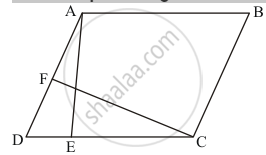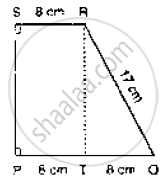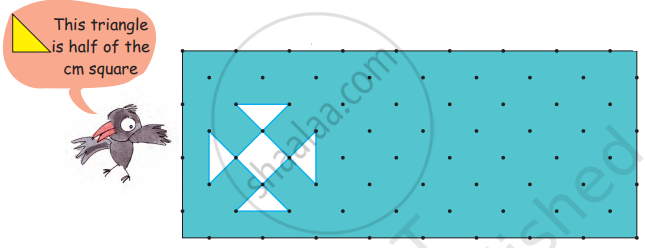Advertisements
Advertisements
प्रश्न
In the given figure, ABCD is a parallelogram. If AB = 12 cm, AE = 7.5 cm, CF = 15 cm, then AD =

उत्तर
Given: (1) ABCD is a parallelogram.
(2) AB = 12 cm
(3) AE = 7.5 cm
(4) CF = 15cm
To find: AD
Calculation: We know that,
Area of a parallelogram = base × height

Area of a parallelogram ABCD = DC ×AE (with DC as base and AE as height) ……(1)
Area of a parallelogram ABCD = AD ×CF (with DC as base and AE as height) ……(2)
Since equation 1 and 2 both are Area of a parallelogram ABCD
`DC xx AE = AD xx CF`
`AD = (DC xx AE)/(CF)`
`AD = (AB xx AE)/(CF)` (AB = DC , opposite sides of parallelogram are eual )
`AD = (12 xx 7.5)/15`
AD = 6 cm
APPEARS IN
संबंधित प्रश्न
Let ABCD be a parallelogram of area 124 cm2. If E and F are the mid-points of sides AB and
CD respectively, then find the area of parallelogram AEFD.
If ABCD is a parallelogram, then prove that
𝑎𝑟 (Δ𝐴𝐵𝐷) = 𝑎𝑟 (Δ𝐵𝐶𝐷) = 𝑎𝑟 (Δ𝐴𝐵𝐶) = 𝑎𝑟 (Δ𝐴𝐶𝐷) = `1/2` 𝑎𝑟 (||𝑔𝑚 𝐴𝐵𝐶𝐷) .
Compute the area of trapezium PQRS is Fig. below.

A floor is 40 m long and 15 m broad. It is covered with tiles, each measuring 60 cm by 50 cm. Find the number of tiles required to cover the floor.
Find the area of a rectangle whose length = 15 cm breadth = 6.4 cm
Find the area of a rectangle whose length = 24 cm breadth =180 mm
Find the area of a square, whose side is: 4.5 cm.
Which has the bigger area - one of your footprints or the page of this book?
How many tiles like the triangle given here will fit in the white design?
Area of design = ________ square cm

Look at the table. If you were to write the area of each of these which column would you choose? Make a (✓).
| Square cm |
Square meter |
Square km |
|
| Handkerchief | ✓ | ||
| Sari | |||
| Page of your book | |||
| School land | |||
| Total land of a city | |||
| Door of your classroom | |||
| Chair seat | |||
| Blackboard | |||
| Indian flag | |||
| Land over which a river flows |
